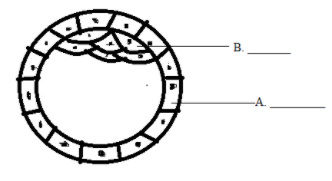
Answer
467.7k+ views
Hint:The morula cells start to initiate cell differentiation during human embryonic development, about 5-6 days after fertilisation, and the morula shifts into the blastocyst.
Complete answer:
First we should know about the blastocyst to answer this question. A complex developed in the early growth of mammals is the blastocyst. It has an inner cell mass that the embryo eventually shapes. The blastocyst's outer layer comprises cells commonly termed trophoblasts.
The internal cell mass and a fluid-filled space identified as the blastocoel are surrounded by this membrane. The placenta is given rise by the trophoblasts Blastocyst development in humans occurs around 5 days after fertilisation if a cavity filled with fluid opens in the morula, the early embryo stage of a 16-cell ball. After rapid cleavage (cell division), the blastocyst has a diameter of approximately 0.1–0.2 mm and contains 200–300 cells. The blastocyst is inserted approximately seven days after fertilization and embedded in the endometrium of the uterine lining. There, it will undergo additional processes of growth, like gastrulation.
The human blastocyst is depicted by the illustration. The name A refers to the trophoblasts that shape the blastocyst’s outer layer of cells. The B name corresponds to the mass of the inner cell. In the development of the embryonic framework, the inner cell mass is included. The placenta shapes the trophoblast.
Note:Blastocyst's inner cell mass are the origins of embryonic stem cells, which are commonly used in stem cell treatments, including reconstruction, substitution and regeneration of cells. The internal cell mass, also recognized as the embryoblast, creates the primitive endoderm and the proper embryo.
Complete answer:
First we should know about the blastocyst to answer this question. A complex developed in the early growth of mammals is the blastocyst. It has an inner cell mass that the embryo eventually shapes. The blastocyst's outer layer comprises cells commonly termed trophoblasts.
The internal cell mass and a fluid-filled space identified as the blastocoel are surrounded by this membrane. The placenta is given rise by the trophoblasts Blastocyst development in humans occurs around 5 days after fertilisation if a cavity filled with fluid opens in the morula, the early embryo stage of a 16-cell ball. After rapid cleavage (cell division), the blastocyst has a diameter of approximately 0.1–0.2 mm and contains 200–300 cells. The blastocyst is inserted approximately seven days after fertilization and embedded in the endometrium of the uterine lining. There, it will undergo additional processes of growth, like gastrulation.
The human blastocyst is depicted by the illustration. The name A refers to the trophoblasts that shape the blastocyst’s outer layer of cells. The B name corresponds to the mass of the inner cell. In the development of the embryonic framework, the inner cell mass is included. The placenta shapes the trophoblast.
Note:Blastocyst's inner cell mass are the origins of embryonic stem cells, which are commonly used in stem cell treatments, including reconstruction, substitution and regeneration of cells. The internal cell mass, also recognized as the embryoblast, creates the primitive endoderm and the proper embryo.
Recently Updated Pages
How is abiogenesis theory disproved experimentally class 12 biology CBSE

What is Biological Magnification

Which of the following reagents cannot distinguish class 12 chemistry CBSE

Which of the following reagents cannot distinguish class 12 chemistry CBSE

Which of the following reagents cannot distinguish class 12 chemistry CBSE

Which of the following reagents cannot distinguish class 12 chemistry CBSE

Trending doubts
Which are the Top 10 Largest Countries of the World?

What is the definite integral of zero a constant b class 12 maths CBSE

Differentiate between homogeneous and heterogeneous class 12 chemistry CBSE

What are the major means of transport Explain each class 12 social science CBSE

Explain sex determination in humans with the help of class 12 biology CBSE

How much time does it take to bleed after eating p class 12 biology CBSE





